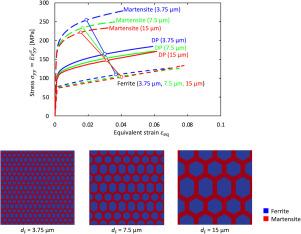Dislocation-based crystal plasticity simulation on grain-size dependence of mechanical properties in dual-phase steels
IF 3.8
3区 工程技术
Q1 MECHANICS
International Journal of Solids and Structures
Pub Date : 2025-08-30
DOI:10.1016/j.ijsolstr.2025.113634
引用次数: 0
Abstract
In this study, the effect of ferrite grain size on the mechanical properties and dislocation behavior of dual-phase (DP) steel is investigated using dislocation-based crystal plasticity finite element analysis. DP steel, composed of a soft ferritic phase and a hard martensitic phase, shows mechanical properties that are significantly influenced by ferrite grain size. The mechanism underlying this grain size effect is clarified by analyzing the partitioning and distribution of stress, strain, and dislocations in each phase. Three models with the same volume fraction of martensitic phase but different ferrite grain sizes are subjected to tensile loading. Interestingly, even though only the ferrite grain size is changed, the stress in the martensitic phase exhibited a notable dependence on ferrite grain size. This can be explained as follows. Geometrically necessary (GN) dislocations accumulate on the ferrite side of the ferrite–martensite grain boundary, and the grain boundary occupancy per unit area increases as the ferrite grain size decreases. As a result, smaller ferrite grain sizes make the ferritic phase less deformable owing to the effect of GN dislocations, shifting more deformation to the martensitic phase. This behavior is confirmed by the more uniform strain distribution and partitioning observed with decreasing ferrite grain size. As the martensitic phase takes on greater deformation, the statistically stored dislocation density in the martensitic phase becomes ferrite grain size dependent, which in turn leads to the observed grain size dependence of stress in the martensitic phase.

基于位错的双相钢力学性能晶粒尺寸依赖性晶体塑性模拟
本文采用基于位错的晶体塑性有限元分析方法,研究了铁素体晶粒尺寸对双相钢力学性能和位错行为的影响。DP钢由软铁素体相和硬马氏体相组成,其力学性能受铁素体晶粒尺寸的显著影响。通过分析各相中应力、应变和位错的分配和分布,阐明了这种晶粒尺寸效应的机制。对马氏体相体积分数相同但铁素体晶粒尺寸不同的三种模型进行了拉伸加载。有趣的是,即使只改变了铁素体晶粒尺寸,马氏体相的应力也表现出对铁素体晶粒尺寸的显著依赖。这可以解释如下。几何必要位错在铁素体-马氏体晶界铁素体侧积累,单位面积晶界占用率随着铁素体晶粒尺寸的减小而增大。结果,较小的铁素体晶粒尺寸使铁素体相由于GN位错的影响而变形较小,将更多的变形转移到马氏体相。随着铁素体晶粒尺寸的减小,应变分布和分配更加均匀,证实了这一行为。当马氏体相发生较大的变形时,统计上储存在马氏体相中的位错密度与铁素体晶粒尺寸相关,从而导致马氏体相中观察到的应力与晶粒尺寸相关。
本文章由计算机程序翻译,如有差异,请以英文原文为准。
求助全文
约1分钟内获得全文
求助全文
来源期刊
CiteScore
6.70
自引率
8.30%
发文量
405
审稿时长
70 days
期刊介绍:
The International Journal of Solids and Structures has as its objective the publication and dissemination of original research in Mechanics of Solids and Structures as a field of Applied Science and Engineering. It fosters thus the exchange of ideas among workers in different parts of the world and also among workers who emphasize different aspects of the foundations and applications of the field.
Standing as it does at the cross-roads of Materials Science, Life Sciences, Mathematics, Physics and Engineering Design, the Mechanics of Solids and Structures is experiencing considerable growth as a result of recent technological advances. The Journal, by providing an international medium of communication, is encouraging this growth and is encompassing all aspects of the field from the more classical problems of structural analysis to mechanics of solids continually interacting with other media and including fracture, flow, wave propagation, heat transfer, thermal effects in solids, optimum design methods, model analysis, structural topology and numerical techniques. Interest extends to both inorganic and organic solids and structures.

 求助内容:
求助内容: 应助结果提醒方式:
应助结果提醒方式:


